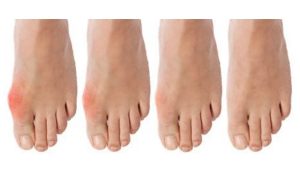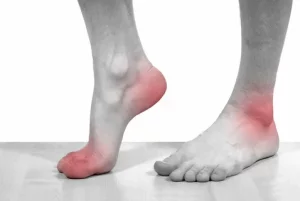Introduction
Gout, a form of inflammatory arthritis, is characterized by painful joint inflammation and swelling. In this comprehensive guide, we will delve into the various aspects of Gout Flare-Ups, including its stages, symptoms, and effective prevention strategies.
Overview
Gout primarily occurs due to the buildup of high levels of urate in the body over an extended period. This excess urate can crystallize into needle-shaped structures in and around the joints, leading to inflammation and arthritis.
Affected Areas
Gout doesn’t limit itself to joints alone; it can affect various body areas, including:
- Joints
- Bursae (cushion-like sacs)
- Tendon sheaths
- Kidneys (leading to stone formation)
Stages of Gout
- Hyperuricemia: Elevated urate levels in the blood, often with crystal formation in the joints but without noticeable symptoms.
- Gout Flares: Periodic, intense attacks of joint pain and swelling.
- Intercritical Gout: The time between flares when no symptoms are present.
- Tophi: A late-stage where needle-shaped crystals accumulate in the skin or other areas, potentially causing permanent damage to joints and internal organs. Timely treatment can prevent tophi development.

Who Gets Gout?
Understanding the demographics of gout is essential for recognizing its prevalence and risk factors.
Demographics and Risk Factors
- Gout is more common in men.
- It typically develops in middle age.
- Women usually experience gout post-menopause, resulting in a later onset compared to men.
- Although less frequent, younger individuals may develop gout, and when they do, the condition often presents with increased severity.
Symptoms of Gout
Recognizing the symptoms of gout is crucial for early diagnosis and effective management.
Common Symptoms
- Sudden Joint Pain: Most often, the first gout flare occurs in the big toe. However, other joints can be affected.
- Swelling and Redness: The affected joint may become visibly swollen, red, and warm.
- Night Attacks: Gout flares often commence suddenly, primarily at night. The pain can be severe enough to wake individuals from sleep.
Triggers for Gout Flares
Gout flares can be triggered by various factors, including:
- Certain foods (high in purines)
- Alcohol consumption
- Specific medications
- Physical trauma
- Certain illnesses

Complications and Health Conditions
Untreated gout can lead to complications and adversely affect various aspects of health.
Potential Complications
- Tophi Development: Crystal buildup under the skin or in organs, potentially causing joint and organ damage.
- Bone and Soft Tissue Damage: Prolonged gout can result in damage to bones and surrounding soft tissues.
- Misshapen Joints: Chronic gout can lead to joint deformities.
Associated Health Conditions
Individuals with gout may be at an increased risk of developing or experiencing:
- Hypertension (high blood pressure)
- Chronic kidney disease
- Obesity
- Diabetes
- Kidney stones (nephrolithiasis)
- Heart-related issues (myocardial infarction, congestive heart failure) want to explore more treatments for different health problems
Causes of Gout
Understanding the root causes of gout involves exploring the role of urate and various contributing factors.
Key Contributors
- High Urate Levels: Gout occurs when urate levels in the body become elevated, leading to crystal formation in the joints.
- Genetic Factors: Family history can play a role in predisposing individuals to gout.
- Gender and Age: Men are more susceptible, and gout typically manifests in middle age. Post-menopausal women also become prone.
- Dietary Factors: Consuming foods rich in purines, which break down into urate, can contribute to gout development.
Risk Factors and Medication
Exploring lifestyle factors and medications that can influence gout risk is crucial for effective prevention.
Contributors to Gout Risk
- Overweight or Obesity: Excess weight can increase the likelihood of developing gout.
- Metabolic Syndrome: A cluster of conditions including high blood pressure, high blood sugar, abnormal cholesterol levels, and excess body fat around the waist.
- Chronic Kidney Disease: Damaged kidneys may struggle to filter urate efficiently.
- High Blood Pressure: Hypertension is often associated with an increased risk of gout.
- Rapid Cell Turnover Conditions: Conditions like psoriasis or certain cancers can elevate the risk.
- Genetic Syndromes: Rare genetic conditions like Kelley-Seegmiller syndrome or Lesch-Nyhan syndrome can lead to increased urate levels.
- Medications: Certain drugs, such as diuretics, low-dose aspirin, niacin (in large amounts), and cyclosporine, can elevate gout risk.
Conclusion
In conclusion, understanding the stages, symptoms, and risk factors associated with gout is crucial for effective prevention and management. Early diagnosis, lifestyle adjustments, and appropriate treatment can significantly mitigate the impact of this common inflammatory arthritis. By embracing a proactive approach and making informed choices, individuals can empower themselves to navigate and control the challenges posed by gout.




